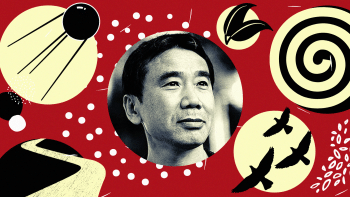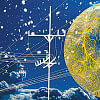The strange library of Haruki Murakami

Haruki Murakami has always been a sort of enigma to me, his strange worlds have drawn me in time and time again. A Strange Library hasn't failed to do the same. After reading Morisaki Boighorer Dinguli (Abosar Prokashona Shongstha, 2023), I was excited to begin another Bengali translation of one of my favorite authors. The chance of hitting two birds with one stone was far too strong for me to ignore. That's how I ended up ordering Odbhut Library (Nautilus Prokashoni, 2024) translated into Bangla by Lutful Kaiser.
The book, though short, bursts with magic. It is a familiar Murakami, where the author sprinkles in bits of whimsy without explanation. The story begins with the protagonist, an unnamed boy, reminiscent of the one in Colorless Tsukuru Tazaki and His Years of Pilgrimage (Knopf, 2014), standing before a library, determined to unravel the mysteries of the Ottoman tax collection system. Following his mother's advice to pursue what interests him, he dives in. Simple enough, right? But entering the library, he's directed to room 107 where an enigmatic old man awaits to assist him in his quest for knowledge.
Initially a children's story, A Strange Library presents a mysterious blend of narrative and illustrations, immersing readers into its eerie atmosphere. The transition from text to vivid illustrations done by Chip Kidd enhances the unsettling ambiance, capturing the imagination of readers, regardless of age. As we, alongside our protagonist, step into room 107, the page transforms into an illustration of the door marked with the number 107. Similarly, when encountering the eerie old man, we're confronted with a chilling illustration enough to give little eight-year-olds a fright.
As the story unfolds, the old man's demeanor grows increasingly menacing, compelling the boy to undertake a daunting task—delving into the depths of Ottoman tax records. Descending into a labyrinth beneath the library, the boy faces confinement and the grim prospect of his own demise at the hands of the old man. However, amidst the darkness, a familiar character emerges—the 'sheep man' from A Wild Sheep Chase (Knopf, 2002)—and injects moments of levity to balance the narrative's darker undertones. The sheep man brings the boy food, gives him company, and most importantly, breaks the news that when the boy will complete his task of reading the books, the old man will devour the ripe brains of the boy.
This journey parallels themes found in Murakami's other works, such as the blurred boundaries between reality and illusion, reminiscent of the dual worlds in 1Q84 (Knopf, 2011). The shifting landscapes and uncertain identities evoke a sense of disorientation, mirroring the protagonist's journey through the strange library. Through intricate storytelling and evocative imagery, Murakami invites readers to ponder deeper philosophical questions surrounding existence and perception.
Before I sat down to write this piece, I read both the Bangla translation and the English translation by Ted Goossen which was published by Knopf in 2014. While both versions tell the same tale, Goossen's translation masterfully captures the atmosphere and tone required by such a narrative. Similarly, the illustrations in the 2014 edition, akin to the stills in Wes Anderson movies, play a pivotal role in bringing the world to life. However, in Nautilus Prokashoni's rendition of the publication, the illustrations feel more like an afterthought, clumsily inserted between passages, serving merely to fill space.
In the end, one can't discern whether the tale is grounded in reality, spun from the threads of a dream, or haunted by the specters of a nightmare. Deliberately, I've left certain strands of the narrative untouched in this review, inviting readers to unearth their own revelations, much like the book itself, which revels in ambiguity and invites interpretation. Unlike fantasy, where worlds are meticulously explained, in Murakami's realm, magic simply exists.
Nafis Anwar is probably listening to 'Ekanto Golaap' by Indalo as you're reading this.

 For all latest news, follow The Daily Star's Google News channel.
For all latest news, follow The Daily Star's Google News channel. 










Comments